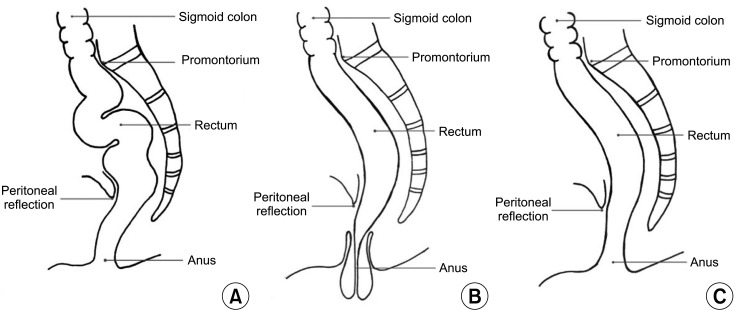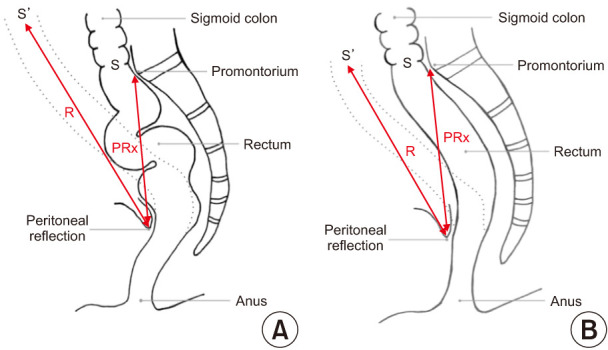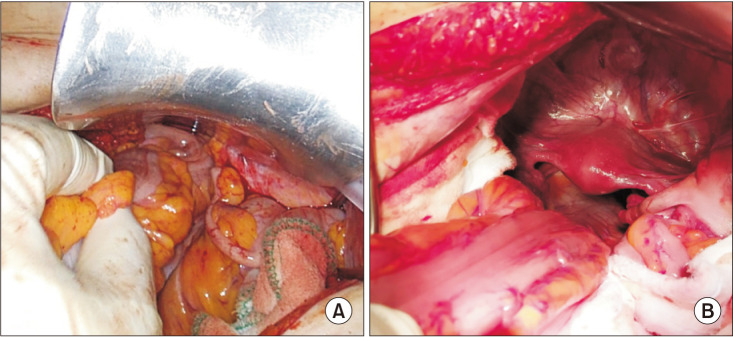Ann Surg Treat Res.
2022 May;102(5):289-293. 10.4174/astr.2022.102.5.289.
The role of rectal redundancy in the pathophysiology of rectal prolapse: a pilot study
- Affiliations
-
- 1Department of General Surgery, Marmara University School of Medicine, Istanbul, Turkey
- KMID: 2529684
- DOI: http://doi.org/10.4174/astr.2022.102.5.289
Abstract
- Purpose
Rectal prolapse is hypothesized to be caused due to weakness of the pelvic floor which is related to childbearing. However, half of the female patients with rectal prolapse were reported to be nulliparous and this hypothesis doesn’t explain the prolapse in males. The aim of this study is to evaluate the role of rectal redundancy in rectal prolapse pathophysiology.
Methods
This study was conducted prospectively. Fourteen patients who underwent rectopexy were included in the study group. A total of 17 patients who underwent laparotomy for another reason and who have no symptoms regarding rectal prolapse were included in the control group. In order to measure the redundancy of the rectum, we have calculated the ratio of length of intraperitoneal rectum (R) to length of distance between promontorium and peritoneal reflection (PRx). The primary outcome of this study was to evaluate whether the R/PRx ratio is higher in patients with rectal prolapse compared to the control group.
Results
Comparing the anatomic features showed that the length of sigmoid colon and length of PRx were not significantly different between the two groups. However, the length of intraperitoneal rectum was significantly higher in the prolapse group. Furthermore, the median R/PRx ratio in the prolapse group was significantly higher than in the control group.
Conclusion
This study showed that intraperitoneal rectum in patients with rectal prolapse is significantly more redundant than in the normal population. This could be considered reasonable evidence for the role of rectal redundancy on rectal prolapse pathophysiology.
Keyword
Figure
Reference
-
1. Mills S. Chapter 33: Rectal prolapse. Beck DE, Roberts PL, Saclarides TJ, Senagore AJ, Stamos MJ, Wexner SD, editors. ASCRS textbook of colon and rectal surgery. 2nd ed. New York: Springer;2011.2. Varma M, Rafferty J, Buie WD. Standards Practice Task Force of American Society of Colon and Rectal Surgeons. Practice parameters for the management of rectal prolapse. Dis Colon Rectum. 2011; 54:1339–1346. PMID: 21979176.3. Goldstein SD, Maxwell PJ 4th. Rectal prolapse. Clin Colon Rectal Surg. 2011; 24:39–45. PMID: 22379404.4. Sun C, Hull T, Ozuner G. Risk factors and clinical characteristics of rectal prolapse in young patients. J Visc Surg. 2014; 151:425–429. PMID: 25242503.5. O’Brien DP 4th. Rectal prolapse. Clin Colon Rectal Surg. 2007; 20:125–132. PMID: 20011387.6. Bordeianou L, Hicks CW, Kaiser AM, Alavi K, Sudan R, Wise PE. Rectal prolapse: an overview of clinical features, diagnosis, and patient-specific management strategies. J Gastrointest Surg. 2014; 18:1059–1069. PMID: 24352613.7. Pucciani F. Rectal prolapse: pathophysiology. Altomare DF, Pucciani F, editors. Rectal prolapse. Milano: Springer, Milano;2008. p. 13–19.8. Patcharatrakul T, Rao SS. Update on the pathophysiology and management of anorectal disorders. Gut Liver. 2018; 12:375–384. PMID: 29050194.9. Attaallah W. Update on the pathophysiology of rectal prolapse. Turk J Gastroenterol. 2019; 30:1074–1075. PMID: 31258139.10. Wijffels NA, Collinson R, Cunningham C, Lindsey I. What is the natural history of internal rectal prolapse? Colorectal Dis. 2010; 12:822–830. PMID: 19508530.11. WELLS C. New operation for rectal prolapse. Proc R Soc Med. 1959; 52:602–603. PMID: 13843894.12. Madoff RD, Mellgren A. One hundred years of rectal prolapse surgery. Dis Colon Rectum. 1999; 42:441–450. PMID: 10215042.13. Attaallah W, Menek G, Erdaj FA, Inceoglu IY, Kankilic MP, Yilmazer AH, et al. An experimental study on the pathophysiology of rectal prolapse. Turk J Surg. 2021; 37:151–156.





